Bryan L. Programmable controllers. Theory and implementation
Подождите немного. Документ загружается.


PROCESS RESPONSES AND
TRANSFER FUNCTIONS
CHAPTER
FOURTEEN
Mathematics may be defined as the subject in
which we never know what we are talking
about, nor whether what we are saying is true.
—Bertrand Russell
Industrial Text & Video Company 1-800-752-8398
www.industrialtext.com
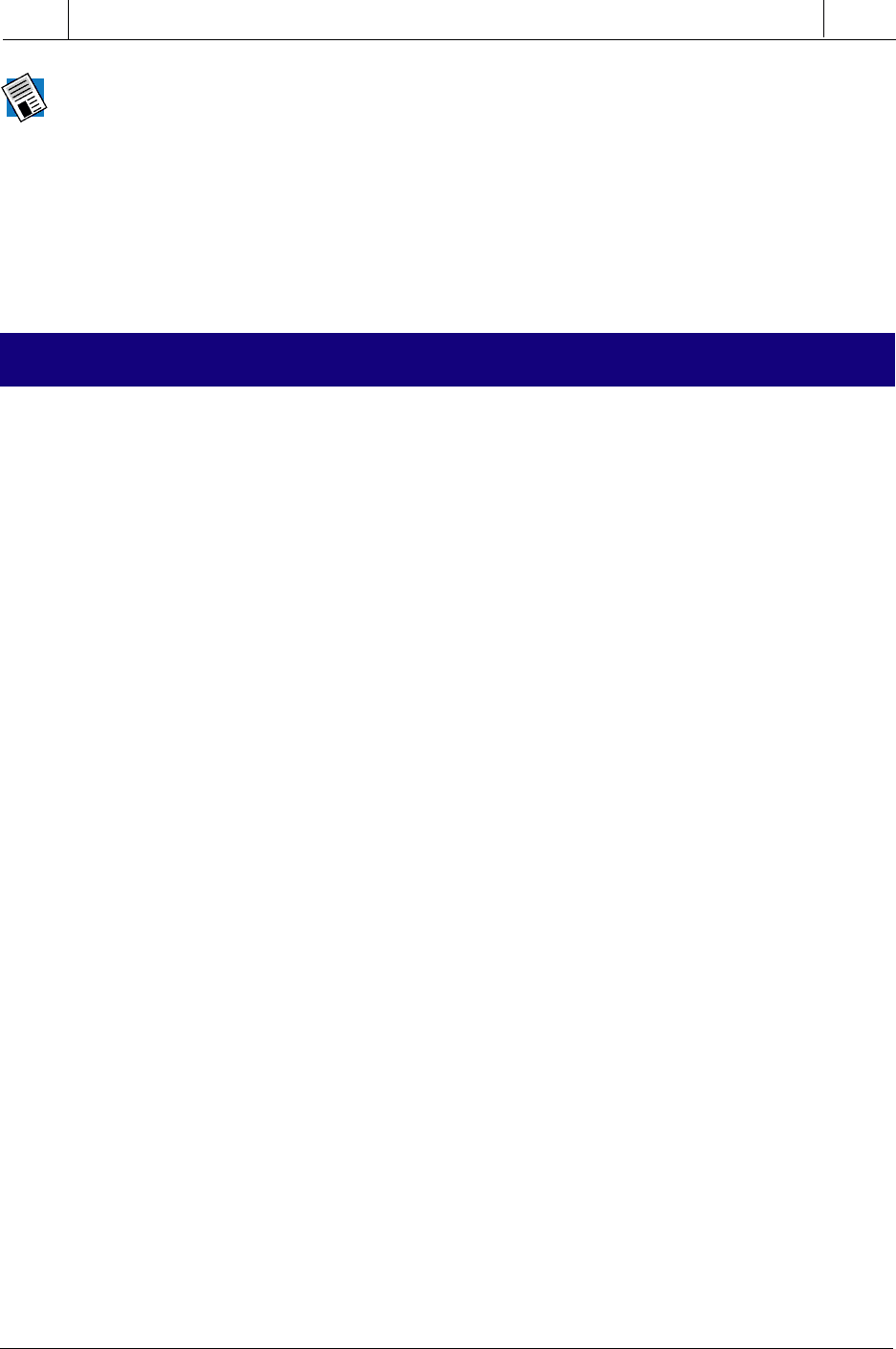
610
SECTION
4
PLC Process
Applications
Industrial Text & Video Company 1-800-752-8398
www.industrialtext.com
CHAPTER
14
Process Responses
and Transfer Functions
As we have already discussed, PLCs control machines and processes via
discrete, analog, and special I/O interfaces that communicate with the real
world. With the aid of control software, a user can program a PLC to control
any process through these I/O interfaces. In our discussion, however, we
have not yet explained process control in its true form, as it applies to the
behavior and control of a manufacturing activity. Therefore, we will
dedicate this chapter to the explanation of basic process control concepts. In
the next chapter, we will explain how these concepts apply to a process
control operation.
CHAPTER
HIGHLIGHTS
14-1 PROCESS CONTROL BASICS
Process control is the regulation of designated process parameters to within
a specified target range or to a set target value called the set point. Process
control is most often used in product manufacturing, because many factors,
such as color, composition, and density, must be accurate for a product to be
well made. Therefore, to implement a quality product, process control is used
to monitor and correct process parameters by analyzing the state of dynamic
variables. Dynamic variables are process characteristics, such as tempera-
ture, flow, and pressure, that vary with time. Through its I/O interfaces, a
PLC can regulate these dynamic variables to a desired set point, thus
implementing process control.
Figure 14-1 illustrates the basic concept of process control using a reactor tank
in which steam controls the temperature in the tank. In this case, the
temperature must be maintained at a target value, or set point, of 125°C.
Because it varies with time, the temperature is the dynamic variable, which
is also called the process variable (PV). The steam level, which regulates
the process variable (i.e., raises and lowers the temperature), is called the
control variable (CV). The valve that controls the amount of steam entering
the reactor tank’s jacket is called the control element, or final output field
device, because the more the controller opens the valve, the more the steam
increases the temperature.
Figure 14-2 shows the block diagram of the process control system illus-
trated in Figure 14-1. The PLC reads the process variable from the system
(i.e., obtains feedback) and compares it with the set point to determine how
well the temperature is being regulated. This configuration is known as a
closed-loop system, because the controller uses feedback to monitor the
system. An open-loop system does not use feedback, so the controller does
not receive process variable data. Figure 14-3 illustrates the configuration of
an open-loop system.
If the temperature reading in the process in Figure 14-2 is low, the controller
will adjust the control variable by opening the valve to allow steam to enter
the tank, thereby raising the temperature. The controller will then recheck

611
CHAPTER
14
Process Responses
and Transfer Functions
Industrial Text & Video Company 1-800-752-8398
www.industrialtext.com
SECTION
4
PLC Process
Applications
Hc
E
=
SP
–
PV CVSP
+
–
Σ
Steam
Temperature
Sensor
Product Discharge
Water
Material 1
Material 2
Figure 14-1. Reactor tank control system.
Figure 14-2. Block diagram of the closed-loop reactor tank system.
Figure 14-3. Open-loop process control system.
Controller Process
E
=
SP
–
PVSP
Temperature
CV PV
Steam
Valve
Control
Temperature
PV
+
–
Σ
Feedback
Controller Process
CVSP PV
the process variable. If the temperature is still low, it will again open the
steam valve to increase the temperature. The controller will repeat this
process until the actual temperature (process variable) is as close as possible
to the target temperature (set point value). The difference between the process
variable and the set point is called the error. The error can be either positive
or negative, depending on whether the process variable is too high or too low.
However, regardless of the sign of the error, the controller still performs the
same basic function—adjusting the process variable until it equals the set
point (i.e., making the error equal to zero). Once equality is achieved, the
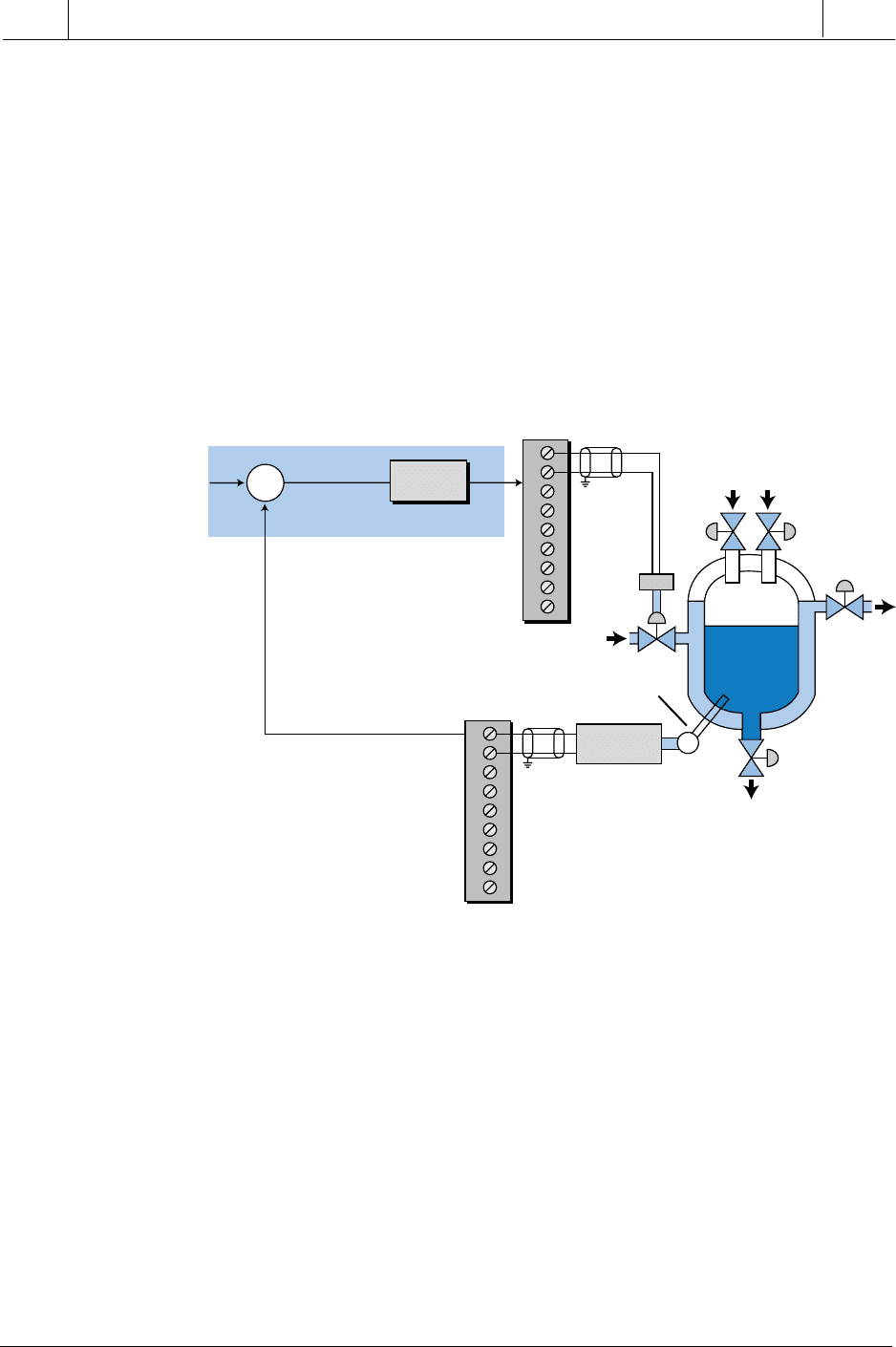
612
SECTION
4
PLC Process
Applications
Industrial Text & Video Company 1-800-752-8398
www.industrialtext.com
CHAPTER
14
Process Responses
and Transfer Functions
Figure 14-4. Control system block diagram including I/O interfaces.
E
=
SP
–
PV CVSP
+
–
Σ
Steam
Product Discharge
Water
Material 1
Material 2
Controller
PV
PLC
+
–
1
1C
1
1C
+
–
Analog Output
Module
Analog Input
Module
Temperature
Sensor
Transmitter
process is said to be regulated. As we will discuss later, many factors can
disturb the system, thus altering the process variable. Therefore, the controller
must adjust the control variable to correct for errors created by these factors,
as well as to correct for errors due to a change in the set point.
In a PLC-based system, a control system block diagram like the one shown
in Figure 14-2 can be expanded to include interfaces that control the field
output devices, as well as those that read process variable input data (see
Figure 14-4). Figure 14-5 shows a control system that uses a PID interface
(discussed in Chapter 8) to implement process control independent of the
PLC. The next chapter will further explain PID control.
The adjustment of the control variable according to data obtained by reading
the process variable and analyzing the error between it and the set point is
referred to as the control loop. Most control loops are affected by distur-
bances, which influence the process and alter the process variable (see Figure
14-6). To understand disturbances, let’s examine a simple control loop
example—a car’s cruise control mechanism. As shown in Figure 14-7, once
the cruise control has been set at a target speed (set point), the system will
maintain that speed by keeping the accelerator (control variable) at a
constant level. However, if the system experiences a disturbance, such as
pavement with higher friction or an uphill climb, the system will increase
the control variable (i.e., increase acceleration) to maintain the set point
speed. This is demonstrated by the fact that the accelerator pedal of a car
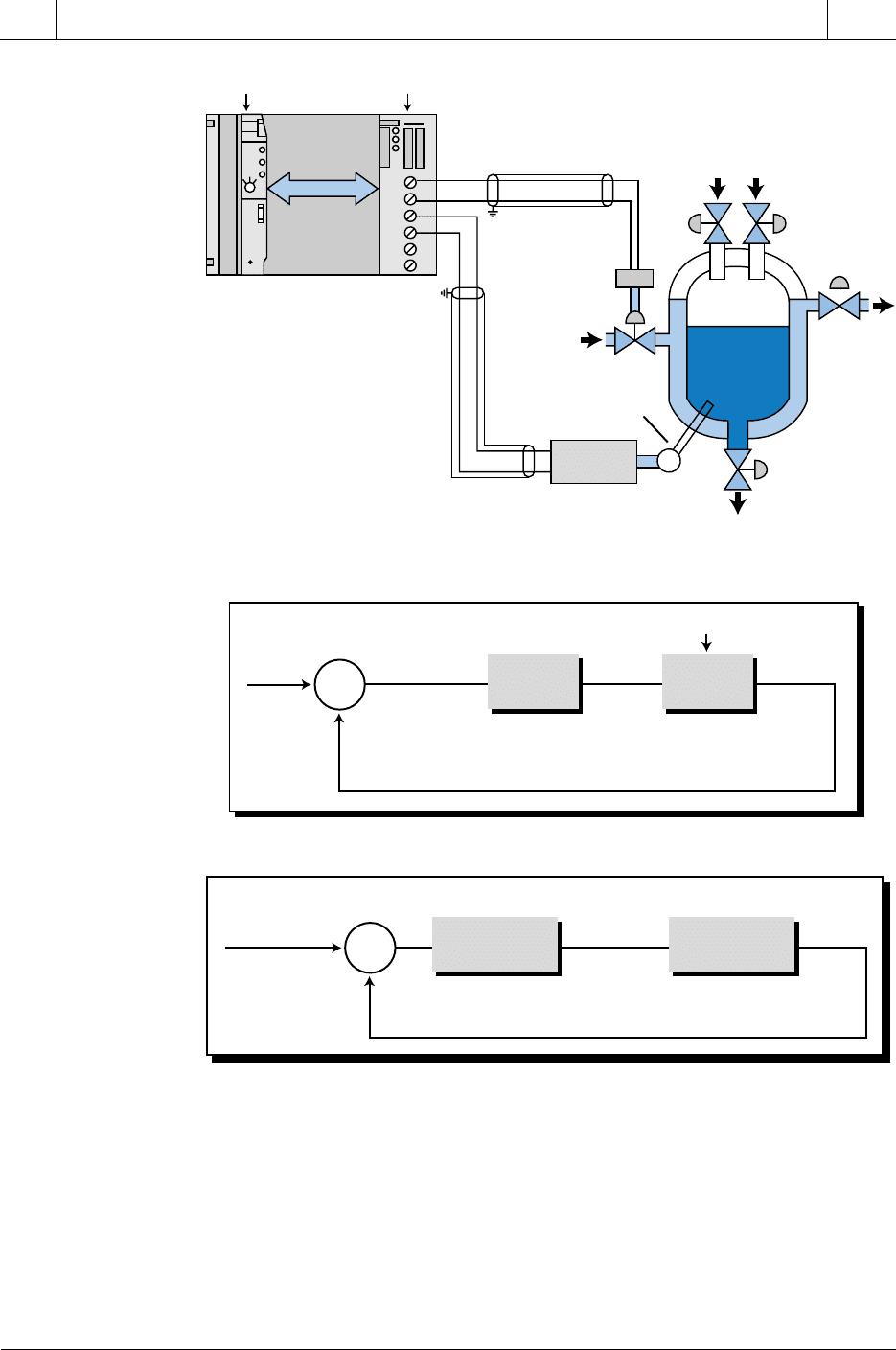
613
CHAPTER
14
Process Responses
and Transfer Functions
Industrial Text & Video Company 1-800-752-8398
www.industrialtext.com
SECTION
4
PLC Process
Applications
Figure 14-5. Control system using a PID interface.
Figure 14-6. A control loop with a disturbance.
Figure 14-7. Cruise control process loop.
Block
Transfer
Processor PID Module
Steam
Product Discharge
Water
Material 1
Material 2
1
1C
+
–
Temperature
Sensor
Transmitter
Cruise Speed
Controller
Car’s Engine
& Drive Train
E
Set Point
(Desired
Cruise Speed)
PV
+
–
Σ
(Actual Speed)
Accelerator
Pedal
Actual
Speed
Controller Process
E
=
SP
–
PVSP CV PV
PV
+
–
Σ
Disturbance
Controller must adjust its
output to correct for the error
created by a disturbance
under cruise control is depressed further when the car is going uphill than
when it is going downhill. Figure 14-8 illustrates how a cruise control system
compensates for disturbances. The components that form this simple system
respond to keep the process variable at the set point by adjusting the control
variable to maintain the error at zero during the disturbance. This, in fact, is
the main function of process control—monitoring the error signal generated
by the system and adjusting the outputs accordingly.
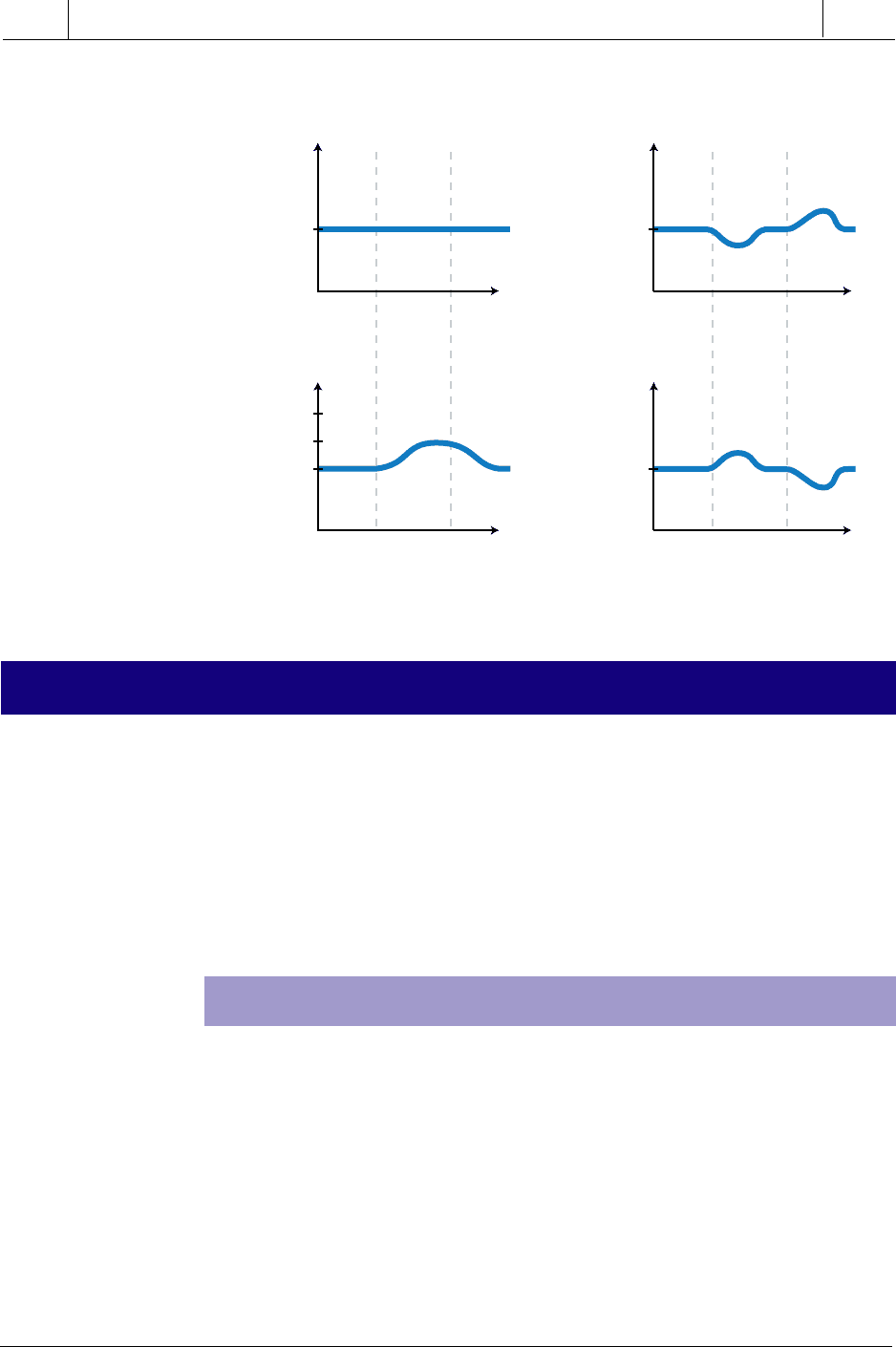
614
SECTION
4
PLC Process
Applications
Industrial Text & Video Company 1-800-752-8398
www.industrialtext.com
CHAPTER
14
Process Responses
and Transfer Functions
Figure 14-8. Cruise control compensation graphs showing (a) the set point speed, (b) the
reaction of the process variable to the disturbance, (c) the reaction of the
control variable to the disturbance, and (d) the error.
14-2 CONTROL SYSTEM PARAMETERS
As we just discussed, a controller calculates the process error (E) as the
difference between the set point (SP) and the process variable (PV). It then
uses this error data as the input for its control computations. It uses this input
data to apply control to the process by manipulating the control variable (CV)
so as to eliminate the error. The way it does this depends on the controller’s
mode (covered in the next chapter) and the degree of error. Therefore, a thorough
understanding of the relationship between error and the control variable is
beneficial when designing and applying a process control application.
ERROR
The control deviation, or error, between the set point and the process variable
is given by the equation:
ESPPV=−
where:
E
SP
PV
=
=
=
the error
the set point value
the process variable value
SP
= 70 mph
Speed
Hill
Begins
Hill
Ends
50%
0%
70%
100%
Accelerator
Time
Time
70 mph
Speed
Feedback
PV
Hill
Begins
Hill
Ends
0
+
–
Error
SP
–
PV
Time
Time
(a) (b)
(c) (d)
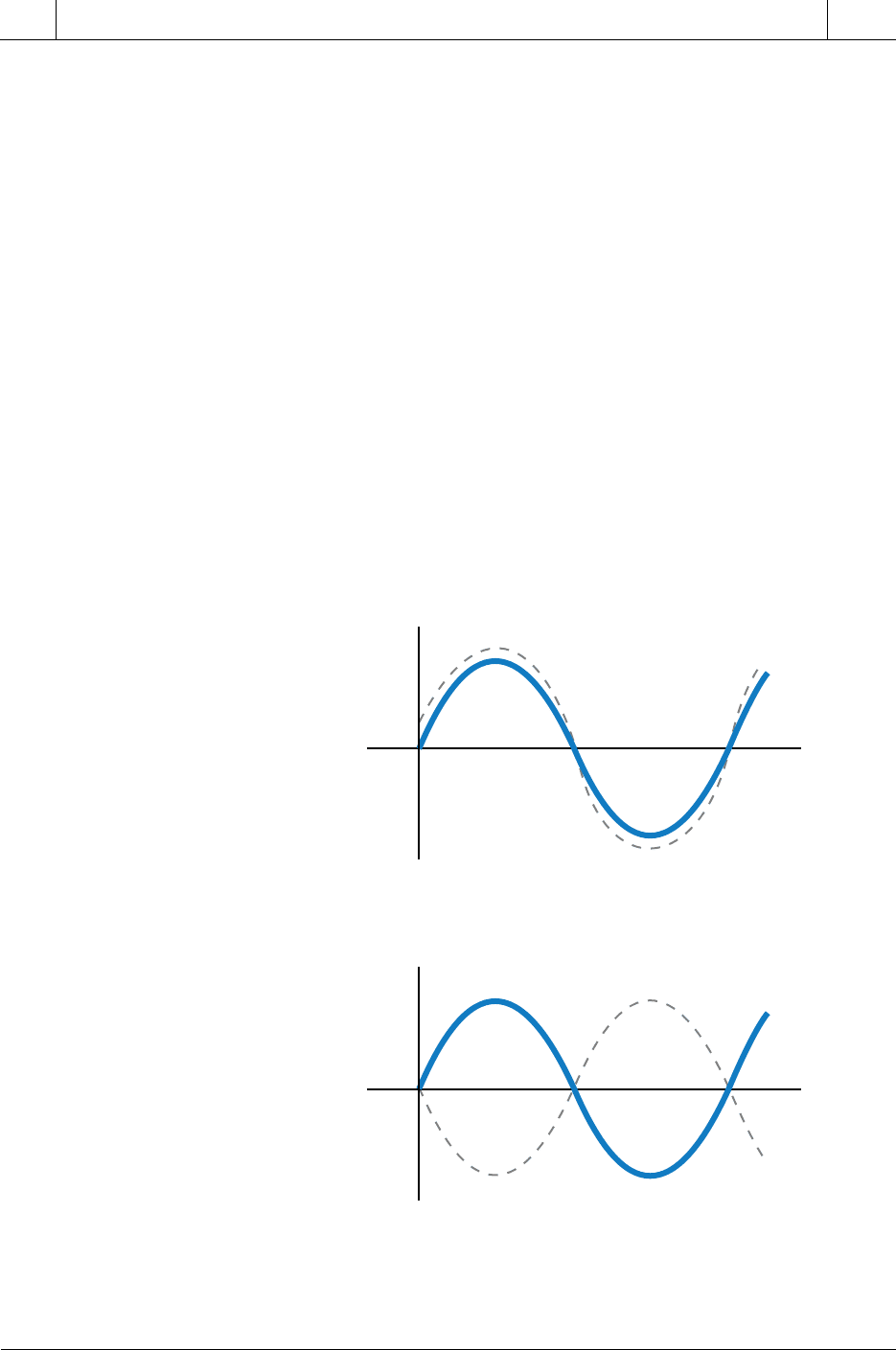
615
CHAPTER
14
Process Responses
and Transfer Functions
Industrial Text & Video Company 1-800-752-8398
www.industrialtext.com
SECTION
4
PLC Process
Applications
Figure 14-9. (a) Positive and (b) negative feedback.
This equation can also be represented as:
EPVSP=−
where the set point is subtracted from the process variable. Both equations
give the same magnitude (value) of error, but with different signs. The first
error equation (E = SP – PV) is used in negative feedback control loops, where
the process variable is fed back into the system and subtracted from the set
point for error correction control. Negative feedback is used in closed-loop
control systems instead of positive feedback, because negative feedback
reduces the error in the system while positive feedback magnifies it. As
shown in Figure 14-9a, positive feedback results in a feedback signal that is
in phase with the error deviation, thus enhancing the system error. Negative
feedback, on the other hand, produces a signal that is directly out of phase with
the error deviation (see Figure 14-9b). This reversal of phase causes the
system error to decrease as the control variable regulates the process. All
feedback controllers produce a 180° phase shift in the feedback signal to
provide negative feedback.
Negative Feedback
(b)
Positive Feedback
(a)

616
SECTION
4
PLC Process
Applications
Industrial Text & Video Company 1-800-752-8398
www.industrialtext.com
CHAPTER
14
Process Responses
and Transfer Functions
INTERPRETATION OF ERROR
The representation of error as the difference between the set point and the
process variable provides a “natural” value; that is, a value expressed in the
units being measured. For example, a PLC that receives process variable and
set point data in the form of analog counts will express the error as a function
of analog counts. Likewise, a system with a set point of 125°C and a process
variable of 120°C will have an error of 5°C. However, the system cannot
determine if 5°C is an acceptable error because it does not know how close the
error is to zero relative to the variable range. Therefore, another way for the
controller to calculate error is as a percentage of the target set point. This is
expressed as:
E
SP PV
SP
=
−
Using this equation, the error for the previous temperature example would be:
E =
°− °
°
=
125 120
125
4
CC
C
%
This indicates that the 5°C system error is within 4% of the set point target.
This percentage value provides more information than the 5°C error value;
however, the controller requires even more information to adjust the
process correctly.
The expression of error as a percentage of the process variable range
provides an even more indicative value of error. The range of PV indicates
the maximum and minimum values that the process value can have. Figure 14-
10 illustrates the error as a percentage of the process variable range. Math-
ematically, this can be expressed as:
E
SP PV
PV PV
% =
−
−
min max
where:
EPV
SP
PV
PV PV
PV PV
%
max
min
=
=
=
=
=
the error as a percentage of range
the set point
the process variable
the maximum value of
the minimum value of
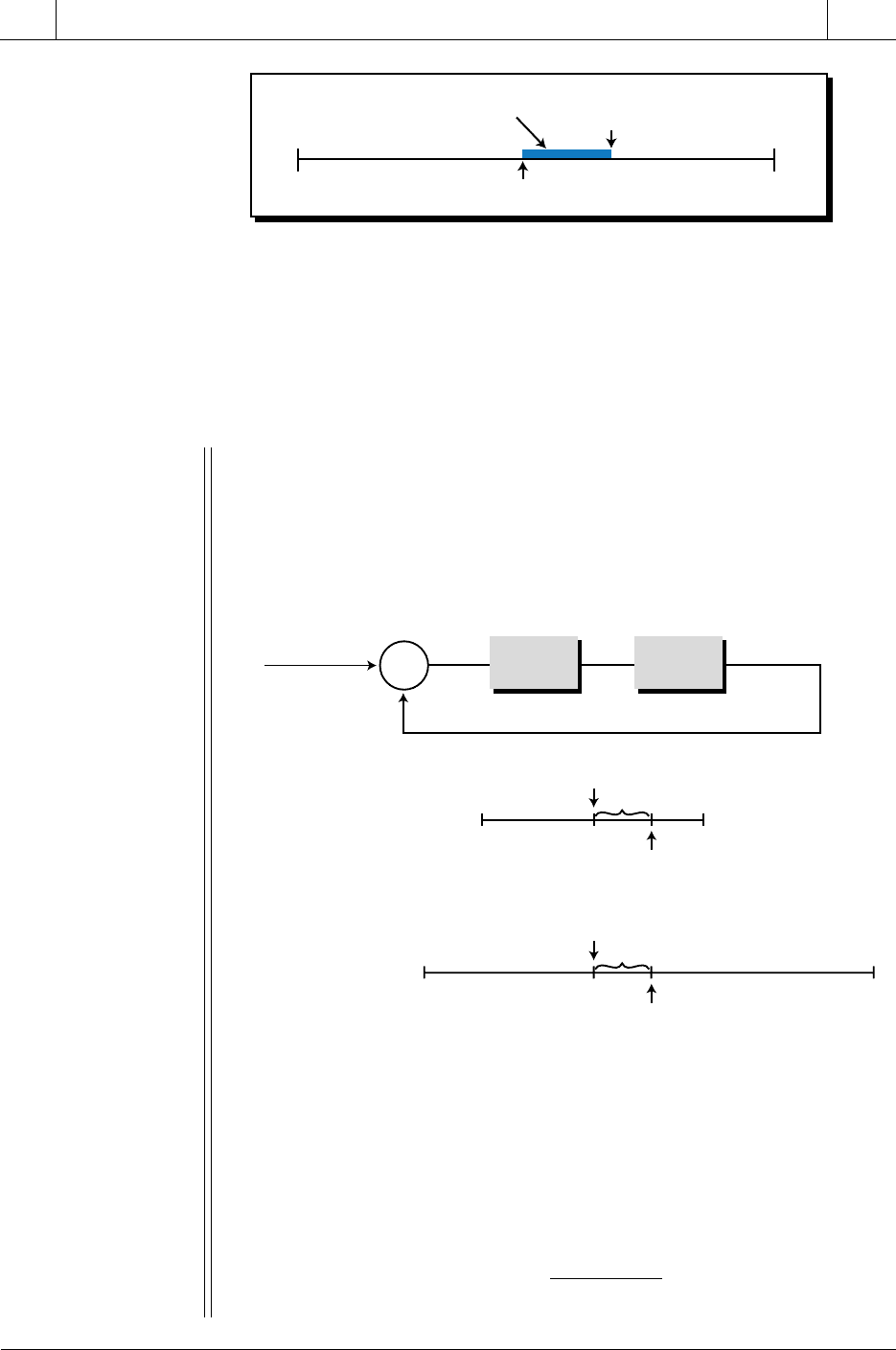
617
CHAPTER
14
Process Responses
and Transfer Functions
Industrial Text & Video Company 1-800-752-8398
www.industrialtext.com
SECTION
4
PLC Process
Applications
Figure 14-10. Error as a percentage of the process variable range.
Figure 14-11. Process control loop for Example 14-1 given (a) a 100–200°C
process variable range and (b) a 50–350°C range.
PV
min
PV
max
SP
PV
Error
Controller Process
ESP
= 180°C
PV
= 168°C
PV
+
–
Σ
(a)
100°C 200°C
PV
= 168°C
SP
= 180°C
(b)
50°C 350°C
PV
= 168°C
SP
= 180°C
Note that, in this equation, the sign of the terms PV
min
and PV
max
(positive and
negative, respectively) are such that the error will be positive if the process
variable is above the set point and negative if it is below the set point. This
error representation provides additional information about the magnitude of
the error.
EXAMPLE 14-1
A process with a temperature set point of 180°C has a process variable
input of 168°C (see Figure 14-11). Express the error as a percentage
of range given that the process variable has a range of (a) 100°C to
200°C and (b) 50°C to 350°C.
S
OLUTION
(a) The value of the error as a percentage of range (
E
%) is expressed
as:
E
SP PV
PV PV
%
min max
=
−
−
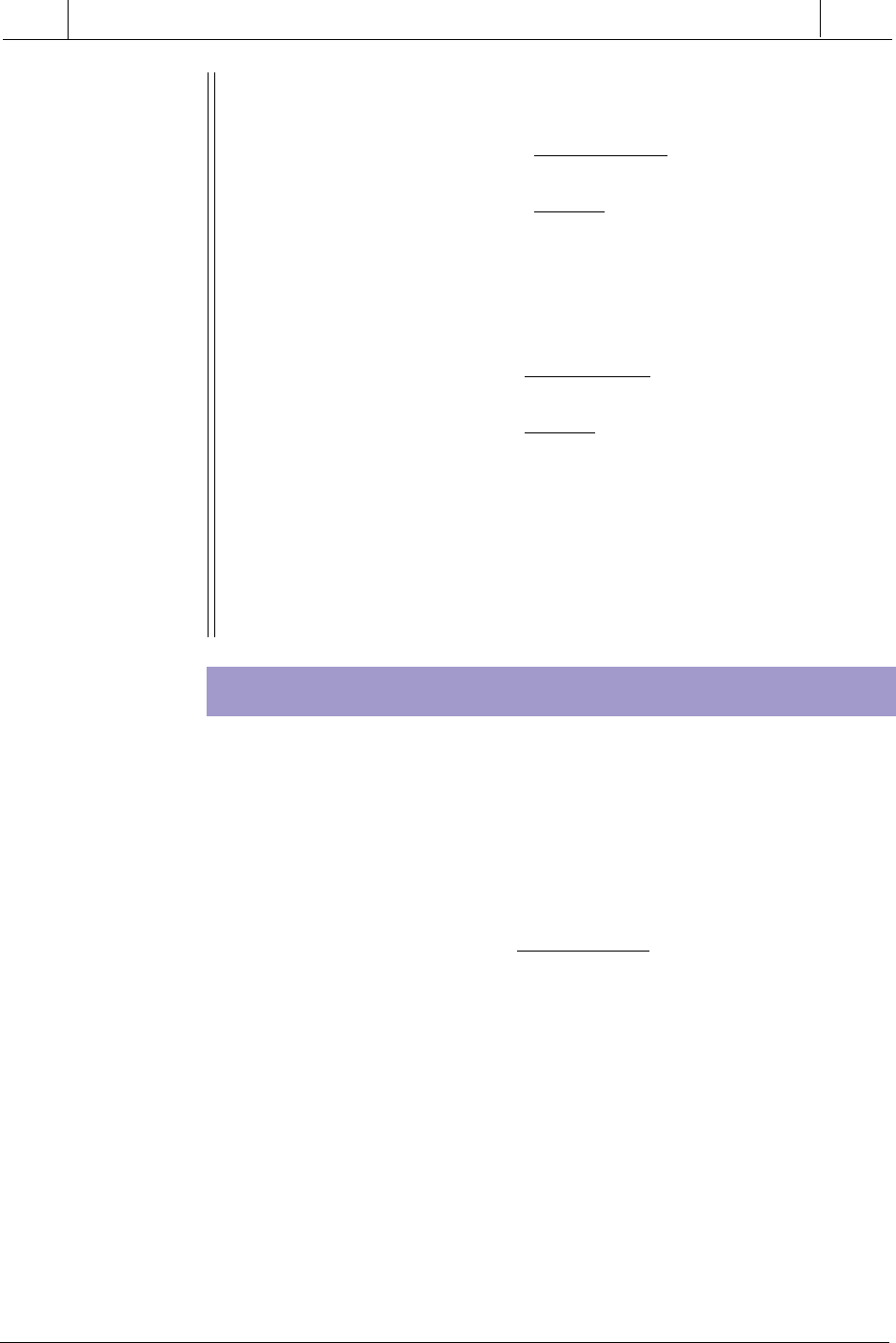
618
SECTION
4
PLC Process
Applications
Industrial Text & Video Company 1-800-752-8398
www.industrialtext.com
CHAPTER
14
Process Responses
and Transfer Functions
For a process variable range of 100 to 200°C, the error is:
E
%
.%
=
°− °
°− °
=
°
−°
=− =−
180 168
100 200
12
100
012 12
CC
CC
C
C
(b) For a process variable range of 50 to 350°C, the error is:
E
%
.%
=
°°
°− °
=
°
−°
=− =−
180 68
50 350
12
300
004 4
C-1 C
CC
C
C
Although the actual natural value of the error is the same in both parts
(a) and (b)—i.e., 12°C—the magnitude of the error in the first case
(12%) is three times greater than the magnitude of the error in the
second case (4%). The negative sign of the error calculations indi-
cates that the process variable is lower than the set point.
THE CONTROL VARIABLE
During the control of a process, the controller calculates the error value and
adjusts the control variable accordingly to bring the error to zero. Like the
error, the value of the control variable can also be expressed as a percentage
of range; however, the control variable is expressed in terms of the full range
of the controller’s output (i.e., the control field device). This range of the
controller output is defined as:
CV
CV CV
CV CV
%
min
max min
=
−
−
actual
where:
CV
CV
CV
CV
%
max
min
=
=
=
=
the control variable value as a percentage of its range
the actual value of the controller output
the maximum value of the controllable signal
the minimum value of the controllable signal
actual
The order and the sign of the nominator and denominator terms in this
equation result in a control variable percentage value that is always positive,
since the value of CV
actual
cannot be less than its minimum possible value.
